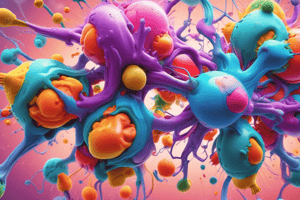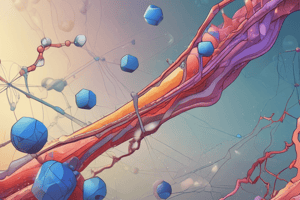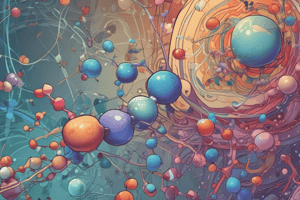Podcast
Questions and Answers
What is the primary determinant of the unique properties and characteristics of each amino acid?
What is the primary determinant of the unique properties and characteristics of each amino acid?
- The amino group (-NH2).
- The carboxyl group (-COOH).
- The R-group (side chain). (correct)
- The central carbon atom.
A protein's function is most directly determined by what aspect of its structure?
A protein's function is most directly determined by what aspect of its structure?
- The sequence of amino acids. (correct)
- The strength of its primary structure.
- The quantity of nitrogen atoms.
- The number of peptide bonds.
Which type of bond is primarily responsible for the primary structure of a protein?
Which type of bond is primarily responsible for the primary structure of a protein?
- Hydrogen bonds.
- Hydrophobic interactions.
- Ionic bonds.
- Covalent bonds. (correct)
What is the most accurate reason for explaining why protein structures are considered dynamic?
What is the most accurate reason for explaining why protein structures are considered dynamic?
How do changes in a protein's structure typically affect its function?
How do changes in a protein's structure typically affect its function?
Which statement accurately describes how an amino acid can act as a base?
Which statement accurately describes how an amino acid can act as a base?
What does it mean for an amino acid to be amphoteric?
What does it mean for an amino acid to be amphoteric?
Which of the following best describes a zwitterion?
Which of the following best describes a zwitterion?
What is the isoelectric point (pI) of an amino acid?
What is the isoelectric point (pI) of an amino acid?
How does the pH of a solution influence the charge of an amino acid?
How does the pH of a solution influence the charge of an amino acid?
Consider an amino acid in a solution where the pH is significantly lower than its isoelectric point (pI). What would be the predominant form of the amino acid in this solution?
Consider an amino acid in a solution where the pH is significantly lower than its isoelectric point (pI). What would be the predominant form of the amino acid in this solution?
Why do different amino acids have different isoelectric points?
Why do different amino acids have different isoelectric points?
In a solution with a pH much higher than the pI of a particular amino acid, what is the expected net charge on the majority of those amino acid molecules?
In a solution with a pH much higher than the pI of a particular amino acid, what is the expected net charge on the majority of those amino acid molecules?
Which type of interaction is most significantly affected by placing a protein in a nonpolar solvent?
Which type of interaction is most significantly affected by placing a protein in a nonpolar solvent?
A mutation replaces an alanine residue with a glutamic acid residue in a protein. How would this change most likely affect non-covalent interactions?
A mutation replaces an alanine residue with a glutamic acid residue in a protein. How would this change most likely affect non-covalent interactions?
Which amino acid is most likely to participate in hydrophobic interactions?
Which amino acid is most likely to participate in hydrophobic interactions?
Which of the following interactions contributes most to the formation of alpha-helices and beta-sheets in proteins?
Which of the following interactions contributes most to the formation of alpha-helices and beta-sheets in proteins?
How do terminal amino and carboxyl groups contribute to the overall stability of a peptide?
How do terminal amino and carboxyl groups contribute to the overall stability of a peptide?
A protein contains a cluster of serine residues. What type of non-covalent interaction could these residues participate in?
A protein contains a cluster of serine residues. What type of non-covalent interaction could these residues participate in?
If a protein's function is highly dependent on ionic interactions, which of the following conditions would most likely disrupt its function?
If a protein's function is highly dependent on ionic interactions, which of the following conditions would most likely disrupt its function?
Two proteins bind to each other via complementary surface charges. Which amino acids are most likely present at the binding interface?
Two proteins bind to each other via complementary surface charges. Which amino acids are most likely present at the binding interface?
Which characteristic of the R-group determines an amino acid's classification as polar or non-polar?
Which characteristic of the R-group determines an amino acid's classification as polar or non-polar?
Considering the chemical properties of amino acid R-groups, which amino acid is most likely found on the exterior of a protein in an aqueous solution?
Considering the chemical properties of amino acid R-groups, which amino acid is most likely found on the exterior of a protein in an aqueous solution?
What type of bond is formed during the primary structure of a protein?
What type of bond is formed during the primary structure of a protein?
If a drug molecule needs to interact with a hydrophobic pocket within an enzyme, which amino acid side chain would be most suitable to modify the drug for improved binding?
If a drug molecule needs to interact with a hydrophobic pocket within an enzyme, which amino acid side chain would be most suitable to modify the drug for improved binding?
How does the zwitterionic form of an amino acid behave in solution?
How does the zwitterionic form of an amino acid behave in solution?
Which level of protein structure is stabilized primarily by covalent bonds?
Which level of protein structure is stabilized primarily by covalent bonds?
Enzymes are proteins that catalyze biochemical reactions. What is a key property of enzymes related to their structure?
Enzymes are proteins that catalyze biochemical reactions. What is a key property of enzymes related to their structure?
How do different intermolecular interactions contribute to the unique functions and properties of proteins?
How do different intermolecular interactions contribute to the unique functions and properties of proteins?
During the formation of a peptide bond, what molecule is released as a byproduct?
During the formation of a peptide bond, what molecule is released as a byproduct?
Which characteristic of a peptide bond contributes most to the secondary structure of proteins?
Which characteristic of a peptide bond contributes most to the secondary structure of proteins?
What type of reaction is required to break a peptide bond?
What type of reaction is required to break a peptide bond?
Which of the following is NOT a characteristic of a peptide bond?
Which of the following is NOT a characteristic of a peptide bond?
How does a disulfide bond contribute to protein structure?
How does a disulfide bond contribute to protein structure?
Which level of protein structure is directly stabilized by disulfide bonds?
Which level of protein structure is directly stabilized by disulfide bonds?
What distinguishes an oligopeptide from a polypeptide?
What distinguishes an oligopeptide from a polypeptide?
If a protein's function is affected by the disruption of its disulfide bonds, which amino acid is most likely present in its structure?
If a protein's function is affected by the disruption of its disulfide bonds, which amino acid is most likely present in its structure?
What chemical formula represents the peptide bond?
What chemical formula represents the peptide bond?
Which type of interaction is NOT primarily responsible for stabilizing the tertiary structure of a protein?
Which type of interaction is NOT primarily responsible for stabilizing the tertiary structure of a protein?
A protein is composed of two identical subunits. What is the correct nomenclature for this protein's quaternary structure?
A protein is composed of two identical subunits. What is the correct nomenclature for this protein's quaternary structure?
Cysteine residues play a unique role in protein folding due to their ability to form which type of bond?
Cysteine residues play a unique role in protein folding due to their ability to form which type of bond?
Which level of protein structure is directly determined by the sequence of amino acids?
Which level of protein structure is directly determined by the sequence of amino acids?
What type of interaction primarily stabilizes alpha-helices and beta-strands within a protein's secondary structure?
What type of interaction primarily stabilizes alpha-helices and beta-strands within a protein's secondary structure?
Consider a protein composed of three polypeptide chains: two are identical, and one is different. What is the MOST appropriate classification for its quaternary structure?
Consider a protein composed of three polypeptide chains: two are identical, and one is different. What is the MOST appropriate classification for its quaternary structure?
Haemoglobin consists of multiple subunits working together to transport oxygen. What is the HIGHEST level of protein structure that haemoglobin possesses?
Haemoglobin consists of multiple subunits working together to transport oxygen. What is the HIGHEST level of protein structure that haemoglobin possesses?
Dengue virus envelope protein dimer is held together by non-covalent interactions and/or disulfide bonds. Which of the following interactions contributes to the stability of the dimer through non-covalent forces?
Dengue virus envelope protein dimer is held together by non-covalent interactions and/or disulfide bonds. Which of the following interactions contributes to the stability of the dimer through non-covalent forces?
Flashcards
Amino Acids
Amino Acids
Building blocks of proteins, composed of carbon, hydrogen, oxygen, and nitrogen.
Amino Acid Structure
Amino Acid Structure
An amino group, carboxyl group, and a unique R-group (side chain).
R-group (Side Chain)
R-group (Side Chain)
These determine the properties of each amino acid.
Levels of Protein Structure
Levels of Protein Structure
Signup and view all the flashcards
Protein Structure Bonds
Protein Structure Bonds
Signup and view all the flashcards
Amino Group
Amino Group
Signup and view all the flashcards
Carboxyl Group
Carboxyl Group
Signup and view all the flashcards
Amphoteric
Amphoteric
Signup and view all the flashcards
Zwitterion
Zwitterion
Signup and view all the flashcards
Isoelectric Point
Isoelectric Point
Signup and view all the flashcards
H3+N – C – COOH
H3+N – C – COOH
Signup and view all the flashcards
H2N – C – COO-
H2N – C – COO-
Signup and view all the flashcards
H3+N – C – COO-
H3+N – C – COO-
Signup and view all the flashcards
Peptide Bond
Peptide Bond
Signup and view all the flashcards
Oligopeptide
Oligopeptide
Signup and view all the flashcards
Polypeptide
Polypeptide
Signup and view all the flashcards
Protein
Protein
Signup and view all the flashcards
Disulfide Bond
Disulfide Bond
Signup and view all the flashcards
Cysteine
Cysteine
Signup and view all the flashcards
N-terminus
N-terminus
Signup and view all the flashcards
C-terminus
C-terminus
Signup and view all the flashcards
Non-Covalent Interactions
Non-Covalent Interactions
Signup and view all the flashcards
H-bonds in Peptide Bonds
H-bonds in Peptide Bonds
Signup and view all the flashcards
Interactions between R-groups
Interactions between R-groups
Signup and view all the flashcards
Terminal Interactions
Terminal Interactions
Signup and view all the flashcards
Hydrophobic Interactions
Hydrophobic Interactions
Signup and view all the flashcards
Ionic Interactions
Ionic Interactions
Signup and view all the flashcards
Peptide Interaction Types
Peptide Interaction Types
Signup and view all the flashcards
Primary Protein Structure
Primary Protein Structure
Signup and view all the flashcards
Secondary Protein Structure
Secondary Protein Structure
Signup and view all the flashcards
Tertiary Protein Structure
Tertiary Protein Structure
Signup and view all the flashcards
Quaternary Protein Structure
Quaternary Protein Structure
Signup and view all the flashcards
Forces Stabilizing Quaternary Structure
Forces Stabilizing Quaternary Structure
Signup and view all the flashcards
Homo-dimer
Homo-dimer
Signup and view all the flashcards
Hetero-dimer
Hetero-dimer
Signup and view all the flashcards
Hemoglobin
Hemoglobin
Signup and view all the flashcards
Amino Acid R-Group
Amino Acid R-Group
Signup and view all the flashcards
Primary Structure
Primary Structure
Signup and view all the flashcards
Secondary Structure
Secondary Structure
Signup and view all the flashcards
Tertiary Structure
Tertiary Structure
Signup and view all the flashcards
Quaternary Structure
Quaternary Structure
Signup and view all the flashcards
Study Notes
Amino Acids
- Amino acids serve as the fundamental building blocks of proteins.
- Primarily composed of carbon, hydrogen, oxygen, and nitrogen.
- Consist of an amino group, a carboxyl group, and a unique R-group (side chain).
- The R-group dictates the specific properties and classification of each amino acid.
- In aqueous solutions, the amino group can accept a proton, while the carboxyl group can release a proton.
- Amino acids are considered amphoteric due to the presence of both acidic and basic functional groups.
- In specific conditions, an amino acid can exist as a zwitterion, possessing both a positive and negative charge, resulting in a net charge of zero.
- The isoelectric point (pI) is the pH at which the zwitterion form is dominant, leading to an overall zero charge for the amino acid.
- At a pH below the isoelectric point, the amino acid gains a positive charge due to protonation.
- At a pH above the isoelectric point, the amino acid becomes negatively charged as it is deprotonated.
- Amino acids are classified into three groups: non-polar, polar uncharged, and polar charged.
- There are 20 naturally occurring amino acids.
- The alpha carbon is the central carbon atom connected to the amino and carboxyl groups, as well as the R-group.
Peptide Bonds, Polypeptides, and Proteins
- A peptide bond is a covalent bond formed between the amino group of one amino acid and the carboxyl group of another, releasing water in the condensation reaction.
- The formula for a peptide bond is -C(=O)NH-.
- Peptide bonds feature double-bond characteristics that make them rigid and flat, restricting free rotation around the C-N bond.
- Chains of amino acids joined by peptide bonds are known as peptides.
- Short chains (typically 2-20 amino acids) are oligopeptides.
- Long chains (typically over 20 amino acids) are polypeptides.
- A protein consists of one or more polypeptide chains folded into a 3D structure.
- Non-covalent interactions can occur between peptide bonds, R-groups, and terminal NH3+ and COO- ends.
- These interactions can be intra molecular (within the same peptide) or inter molecular (between different peptides).
Protein Structure
- Primary structure refers to the amino acid sequence of the polypeptide chain, written from the N-terminus to the C-terminus.
- Secondary structure arises from the folding of the polypeptide chain and includes alpha-helices, beta-pleated sheets, beta-turns, and random coils.
- Secondary structures are stabilized by hydrogen bonds.
- In an alpha-helix, the polypeptide strand coils into a spring-like shape, stabilized by hydrogen bonds between every -NH group and the 4th C=O group.
- Beta-pleated sheets are secondary structures consisting of beta strands connected via hydrogen bonds.
- Beta-strands are short polypeptides typically containing 5-10 amino acids that are fully extended and typically twisted forming a sheet that is also twisted.
- Beta-sheets can be parallel (adjacent strands aligned in the same direction) or anti-parallel (adjacent strands aligned in opposite directions).
- Beta turns are hairpin turns connect beta strands, formed where the polypeptide reverses its direction, held by one or two H-bonds
- Random coils are formed by H-bonds of peptide bonds with functional groups on side chains, or between side chains.
- Tertiary structure is the final 3D structure of the polypeptide, stabilized by a combination of covalent (disulfide bonds) and non-covalent interactions (hydrogen bonds, ionic interactions, hydrophobic interactions).
- Water-soluble proteins typically feature a hydrophobic core and hydrophilic external surfaces in aqueous environments.
- Membrane proteins contain hydrophobic segments that embed in phospholipid bilayers.
- Quaternary structure occurs when two or more proteins with tertiary structures combine to form a larger protein complex
- Each polypeptide within a quaternary structure is known as a subunit with two subunits as a dimer and three as a trimer.
- Subunits are held together by non-covalent interactions and/or disulfide bonds.
- Haemoglobin, responsible for carrying oxygen in red blood cells, exemplifies a heterotetramer quaternary structure comprised of two alpha and two beta subunits.
Studying That Suits You
Use AI to generate personalized quizzes and flashcards to suit your learning preferences.



